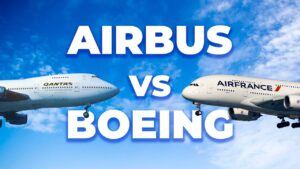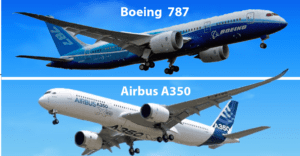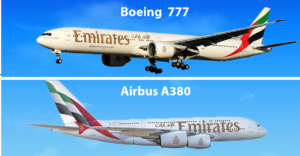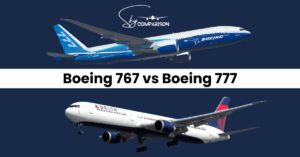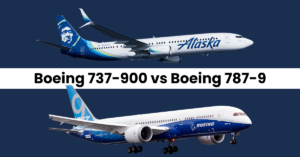Boeing 767 vs 757 | Design, Comfort & Passenger Capacity
Welcome to our in-depth comparison of the Boeing 767 and 757 aircraft models. In this article, we’ll explore the key differences between these two popular Boeing airplanes, providing insights into their design, capabilities, and suitability for various airline operations. Whether you’re a aviation enthusiast or a traveler curious about the aircraft you fly on, join us as we delve into the world of the Boeing 767 and 757, uncovering their unique features and functionalities. Check out our comparison Boeing 757 vs 737 of the to see how they differ.
Boeing 767 vs 757
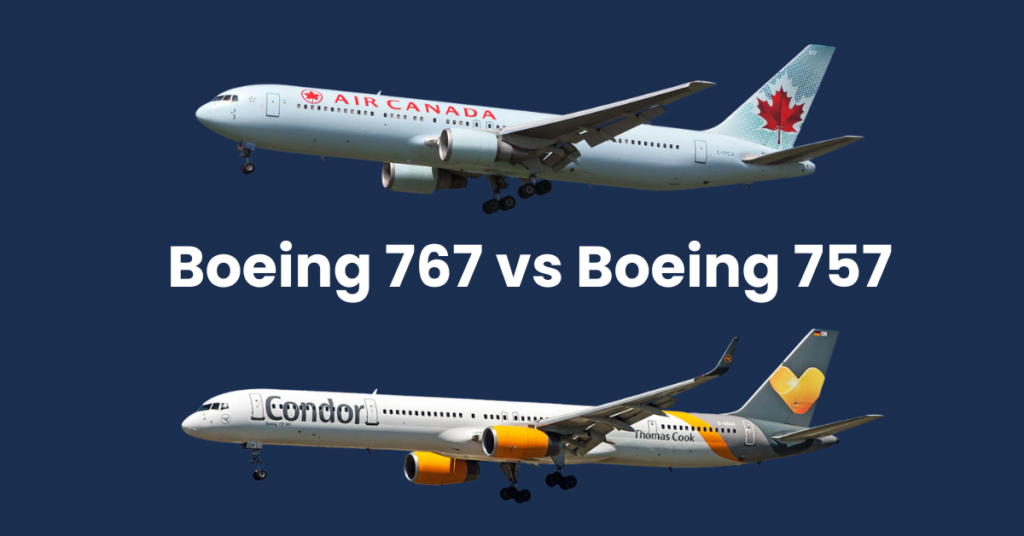
When we look at the Boeing 767 vs Boeing 757, we can see they’re both airplanes, but they have some differences. The Boeing 767 is bigger, like a giant in the sky, with more space inside and stronger engines. It can fly farther too, like it has longer legs for traveling. On the other hand, the Boeing 757 is a bit smaller, like a compact car compared to a big SUV. It might not fly as far, but it can carry more passengers, like a crowded bus. So, if you’re going on a long journey with fewer people, the Boeing 767 might be the way to go. But if you’re taking a lot of folks on a shorter trip, the Boeing 757 could be the better choice. It’s all about picking the right tool for the job!
Boeing 767 vs 757 Variants
When we talk about the Boeing 767 vs Boeing 757, we’re not just talking about one type of plane. There are different versions, or variants, of each model, each with its own special features. Let’s break it down:
Boeing 767 Variants:
- Boeing 767-200: The original version of the 767, with a smaller size and range compared to later variants.
- Boeing 767-200ER: “ER” stands for Extended Range, meaning this variant can fly farther distances without stopping.
- Boeing 767-300: A stretched version of the 767-200, offering more passenger capacity and cargo space.
- Boeing 767-300ER: Similar to the 767-300 but with extended range capabilities for longer flights.
- Boeing 767-400ER: The largest variant of the 767 family, featuring a longer fuselage and increased seating capacity.
Boeing 757 Variants:
- Boeing 757-200: The standard version of the 757, known for its versatility and efficiency.
- Boeing 757-200SF: Converted freighter version of the 757-200, used for cargo transportation.
- Boeing 757-300: A stretched version of the 757-200, offering increased seating capacity for more passengers.
Each variant of the Boeing 767 and 757 has its own strengths and capabilities, catering to different airline needs and operational requirements. Whether it’s long-haul flights, short-haul routes, or cargo transportation, there’s a variant of these aircraft designed to get the job done efficiently and reliably.
Boeing 767-200ER vs 757-200
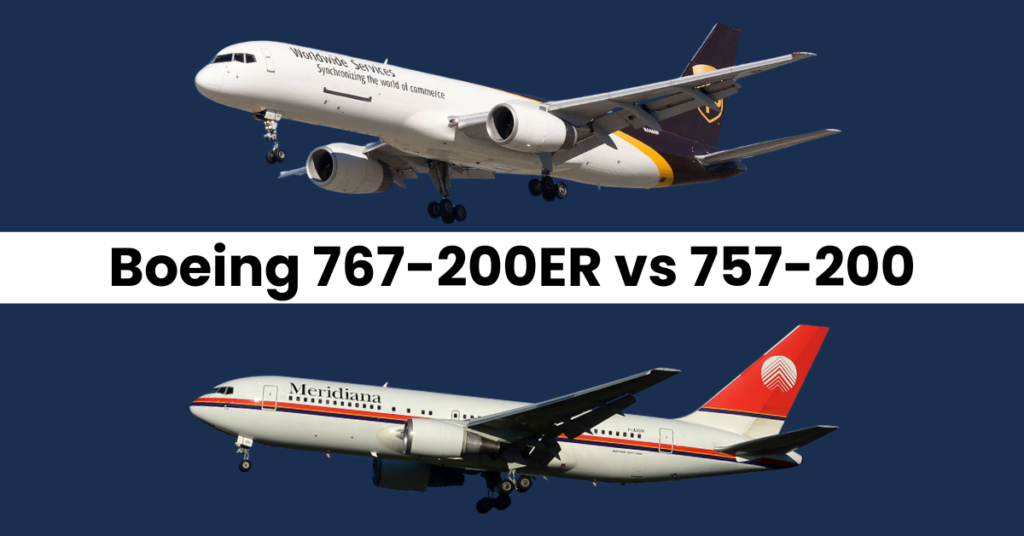
When we look at the Boeing 767-200ER and the Boeing 757-200, we see that the 767-200ER is bigger in size and has stronger engines. It’s longer and has a wider wingspan. Also, it can fly farther, up to 12,200 kilometers. However, the 757-200 can carry more weight when taking off and has room for a few more passengers, about 200. Both planes fly at the same speed though, which is pretty fast! So, if you need to go far and carry a lot, the 767-200ER might be the way to go. But if you’re okay with a bit less space and weight, the 757-200 could do the job just fine.
| Specs | Boeing 767-200ER | Boeing 757-200 |
|---|---|---|
| Length | 48.50 m | 47.32 m |
| Wingspan | 47.60 m | 38.00 m |
| Wing Area | 283.30 m2 | 185.30 m2 |
| Height | 15.80 m | 13.60 m |
| Engines | 2 | 2 |
| Thrust per Engine | 282 kN | 179 kN |
| Total Thrust | 564 kN | 358 kN |
| MTOW | 179,100 kgs | 115,680 kgs |
| Range | 12,200 km | 7,222 km |
| Cruise Speed | M0.8 | M0.8 |
| Capacity | 181 passengers | 200 passengers |
Boeing 767-300ER vs 757-300
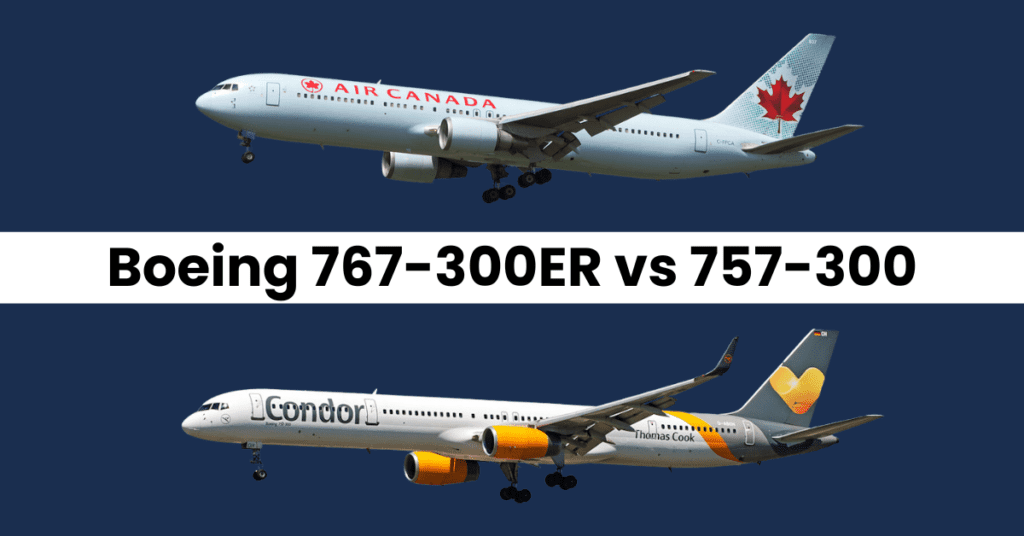
Comparing the Boeing 767-300ER and the Boeing 757-300, we see some clear differences. The 767-300ER is larger in size, with a longer length and wider wingspan compared to the 757-300. It also has a larger wing area and taller height. While both aircraft have two engines, the 767-300ER’s engines provide less thrust per engine but have a higher total thrust compared to the 757-300. The 767-300ER also has a higher maximum takeoff weight (MTOW), allowing it to carry more weight during takeoff. In terms of range, the 767-300ER can fly farther, covering 11,300 kilometers compared to the 6,287 kilometers of the 757-300. However, the 757-300 has a higher passenger capacity, accommodating up to 243 passengers compared to the 218 passengers of the 767-300ER. Both aircraft cruise at the same speed. Overall, the choice between the two would depend on specific needs, such as range requirements and passenger capacity.
| Specs | Boeing 767-300ER | Boeing 757-300 |
|---|---|---|
| Length | 54.90 m | 54.50 m |
| Wingspan | 47.60 m | 38.00 m |
| Wing Area | 283.30 m2 | 185.30 m2 |
| Height | 15.80 m | 13.60 m |
| Engines | 2 | 2 |
| Thrust per Engine | 282 kN | 193 kN |
| Total Thrust | 564 kN | 386 kN |
| MTOW | 186,680 kgs | 123,600 kgs |
| Range | 11,300 km | 6,287 km |
| Cruise Speed | M0.8 | M0.8 |
| Capacity | 218 passengers | 243 passengers |
Design and Configuration
Boeing 767: The Boeing 767 features a wide-body design, offering ample cabin space and enhanced passenger comfort. It typically accommodates between 181 to 375 passengers in a two-class configuration, depending on the variant. The aircraft is available in various models, including the 767-200, 767-300, and 767-400ER, with differences in fuselage length, range, and seating capacity.
Boeing 757: In contrast, the Boeing 757 boasts a narrow-body configuration, optimized for efficiency and versatility on medium-haul routes. It typically seats between 178 to 239 passengers in a two-class layout, with variants such as the 757-200 and 757-300 offering different seating capacities and range capabilities. The narrower fuselage of the 757 enables it to navigate congested airspace and serve airports with limited infrastructure.
Range and Performance
Boeing 767: Renowned for its extended range capabilities, the Boeing 767 is well-suited for long-haul flights and intercontinental operations. Depending on the variant, the aircraft can fly distances ranging from approximately 3,850 to 6,385 nautical miles (nm). Its efficient fuel consumption and spacious cabin make it a preferred choice for airlines operating transatlantic and transpacific routes, as well as cargo operators seeking to transport freight over extended distances.
Boeing 757: While not as renowned for long-range operations as the 767, the Boeing 757 excels in its performance on shorter to medium-haul routes. It offers a maximum range of approximately 3,900 to 4,100 nm, making it suitable for regional flights, domestic services, and operations within North America and Europe. The 757’s superior agility and ability to operate from airports with shorter runways further enhance its appeal for airlines serving niche markets or constrained destinations.
Cargo and Freighter Operations
Boeing 767: One of the key advantages of the Boeing 767 is its versatility as a freighter aircraft. With a wide-body design and spacious cargo hold, the 767 serves as a popular choice for cargo operators transporting goods across continents. Dedicated freighter variants, such as the 767-300F, offer impressive payload capacity and range, making them indispensable assets in the global air cargo industry.
Boeing 757: While primarily designed for passenger operations, the Boeing 757 has also found success as a freighter aircraft, albeit in a more limited capacity compared to the 767. Converted freighter versions of the 757, such as the 757-200SF, offer efficient cargo transportation solutions for express delivery companies and integrators, particularly on routes where demand for freight uplift is sufficient to justify conversion costs.
Operational Flexibility
Boeing 767: With its larger size and extended range capabilities, the Boeing 767 offers airlines a high degree of operational flexibility. Whether flying long-haul routes, serving busy hub airports, or transporting cargo, the 767 adapts to various mission profiles with ease. Its spacious cabin allows for comfortable seating arrangements, while its long-range capabilities enable airlines to connect distant cities and capture market demand across continents.
Boeing 757: The Boeing 757’s narrower body and superior agility make it exceptionally well-suited for operations in challenging environments. Its ability to operate from shorter runways and navigate congested airspace give airlines the flexibility to serve secondary airports and niche markets profitably. The 757’s versatility extends to both passenger and cargo operations, making it a valuable asset for airlines seeking optimized fleet utilization.
Market Demand and Future Prospects
Boeing 767: While demand for new passenger variants of the Boeing 767 has waned in recent years, the aircraft continues to enjoy success in the cargo market, with ongoing production of freighter variants and conversion programs. As global trade and e-commerce continue to drive demand for air cargo services, the Boeing 767 remains a relevant and sought-after solution for freight operators worldwide.
Boeing 757: Despite production ceasing in 2004, the Boeing 757 remains in high demand in the secondary market, reflecting its enduring popularity among airlines seeking efficient narrow-body aircraft. With growing emphasis on sustainability and fuel efficiency, there is renewed interest in the 757 as operators explore options for fleet modernization and replacement. Additionally, cargo conversion programs for the 757 offer potential opportunities for extending the aircraft’s service life.
Conclusion
In the dynamic world of aviation, the comparison between the Boeing 767 and 757 offers valuable insights into the diverse needs and operational nuances of airlines worldwide. Both aircraft, stemming from Boeing’s esteemed 7-series lineage, represent pillars of efficiency, versatility, and reliability in the commercial aviation sector.
The Boeing 767, with its spacious cabin, extended range capabilities, and robust cargo capacity, emerges as a stalwart for long-haul operations and freight transportation. Its ability to traverse vast distances while accommodating a substantial number of passengers or cargo positions it as a cornerstone of global air travel.
FaQs
Which Boeing model is better suited for long-haul flights?
The Boeing 767 is better suited for long-haul flights due to its larger capacity and extended range capabilities. It offers enhanced comfort for passengers and accommodates more cargo, making it an ideal choice for intercontinental routes.
Are the Boeing 767 and 757 similar in design?
While both aircraft belong to Boeing’s popular 7-series family, they exhibit notable differences in design and performance. The Boeing 767 typically features a wider body and greater seating capacity compared to the narrower-bodied Boeing 757.
Can the Boeing 757 operate from shorter runways?
Yes, one of the key advantages of the Boeing 757 is its ability to operate from airports with shorter runways, making it well-suited for serving destinations where space is limited or infrastructure is constrained.
Which aircraft offers better fuel efficiency?
Generally, the Boeing 757 tends to be more fuel-efficient than the Boeing 767 on shorter routes due to its smaller size and lighter weight. However, the fuel efficiency comparison may vary depending on specific operational parameters and configurations.
Are there any plans for successors to the Boeing 767 and 757 models?
Boeing has explored potential successors to the 767 and 757 models through projects such as the Boeing NMA (New Midsize Airplane). However, as of now, there are no firm plans for direct replacements, and airlines continue to operate and maintain these aircraft for their unique capabilities.

